Media's Role in Shaping Public презентация
Media's Role in Shaping Public презентация


#1 слайд
Subject : «Media's Role in Shaping Public
Perception: From News to
Entertainment»
SHYMKENT 20 99Presentation
Prepared by:
Group:
Submitted to:
1 слайд
Subject : «Media's Role in Shaping Public Perception: From News to Entertainment» SHYMKENT 20 99Presentation Prepared by: Group: Submitted to:
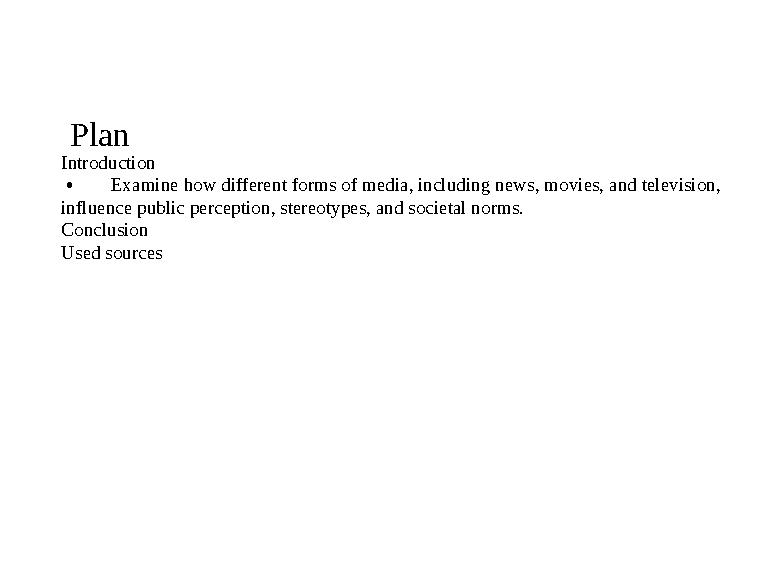
#2 слайд
Plan
Introduction
Examine how different forms of media, including news, movies, and television,
influence public perception, stereotypes, and societal norms.
Conclusion
Used sources
2 слайд
Plan Introduction Examine how different forms of media, including news, movies, and television, influence public perception, stereotypes, and societal norms. Conclusion Used sources
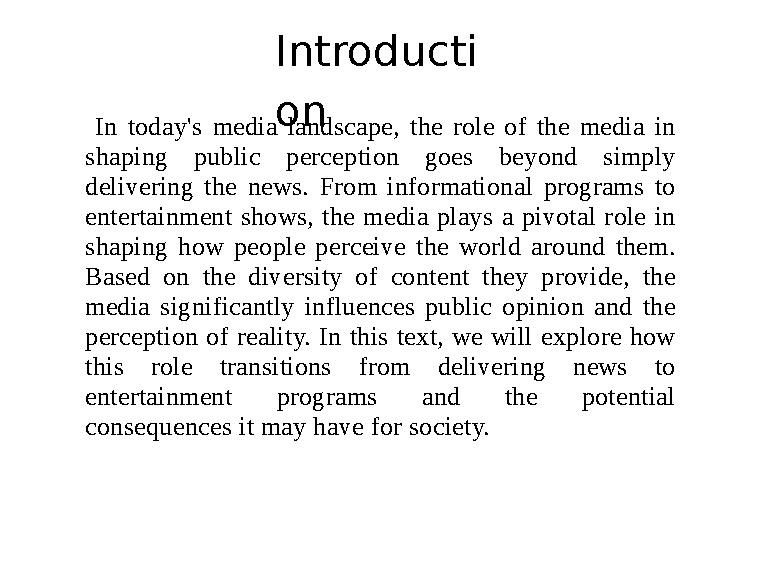
#3 слайд
Introducti
on
In today's media landscape, the role of the media in
shaping public perception goes beyond simply
delivering the news. From informational programs to
entertainment shows, the media plays a pivotal role in
shaping how people perceive the world around them.
Based on the diversity of content they provide, the
media significantly influences public opinion and the
perception of reality. In this text, we will explore how
this role transitions from delivering news to
entertainment programs and the potential
consequences it may have for society.
3 слайд
Introducti on In today's media landscape, the role of the media in shaping public perception goes beyond simply delivering the news. From informational programs to entertainment shows, the media plays a pivotal role in shaping how people perceive the world around them. Based on the diversity of content they provide, the media significantly influences public opinion and the perception of reality. In this text, we will explore how this role transitions from delivering news to entertainment programs and the potential consequences it may have for society.
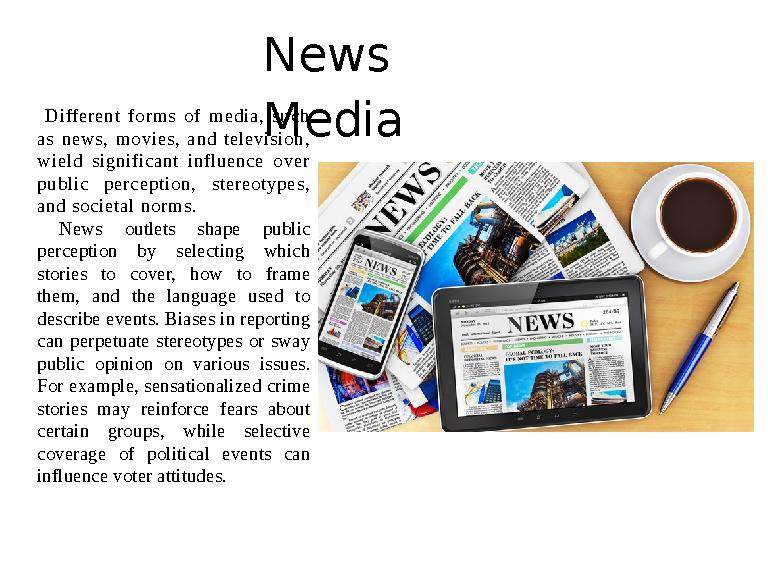
#4 слайд
News
Media Different forms of media, such
as news, movies, and television,
wield significant influence over
public perception, stereotypes,
and societal norms.
News outlets shape public
perception by selecting which
stories to cover, how to frame
them, and the language used to
describe events. Biases in reporting
can perpetuate stereotypes or sway
public opinion on various issues.
For example, sensationalized crime
stories may reinforce fears about
certain groups, while selective
coverage of political events can
influence voter attitudes.
4 слайд
News Media Different forms of media, such as news, movies, and television, wield significant influence over public perception, stereotypes, and societal norms. News outlets shape public perception by selecting which stories to cover, how to frame them, and the language used to describe events. Biases in reporting can perpetuate stereotypes or sway public opinion on various issues. For example, sensationalized crime stories may reinforce fears about certain groups, while selective coverage of political events can influence voter attitudes.
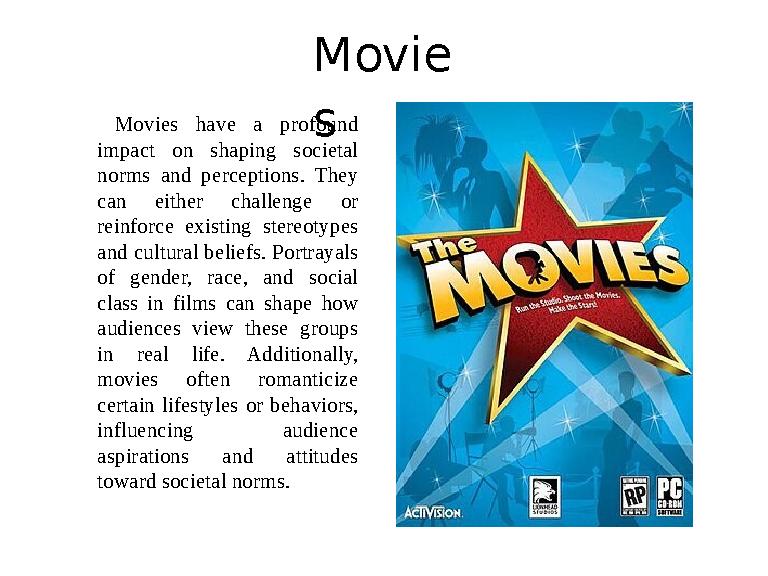
#5 слайд
Movie
s Movies have a profound
impact on shaping societal
norms and perceptions. They
can either challenge or
reinforce existing stereotypes
and cultural beliefs. Portrayals
of gender, race, and social
class in films can shape how
audiences view these groups
in real life. Additionally,
movies often romanticize
certain lifestyles or behaviors,
influencing audience
aspirations and attitudes
toward societal norms.
5 слайд
Movie s Movies have a profound impact on shaping societal norms and perceptions. They can either challenge or reinforce existing stereotypes and cultural beliefs. Portrayals of gender, race, and social class in films can shape how audiences view these groups in real life. Additionally, movies often romanticize certain lifestyles or behaviors, influencing audience aspirations and attitudes toward societal norms.

#6 слайд
Televisi
on
Television programs, including
both scripted shows and reality
TV, play a significant role in
shaping public perception and
stereotypes. Characters and
storylines can reflect or
challenge societal norms,
affecting viewers’ attitudes and
behaviors. Reality TV, in
particular, can reinforce
stereotypes by presenting
exaggerated or scripted
portrayals of certain groups or
individuals.
6 слайд
Televisi on Television programs, including both scripted shows and reality TV, play a significant role in shaping public perception and stereotypes. Characters and storylines can reflect or challenge societal norms, affecting viewers’ attitudes and behaviors. Reality TV, in particular, can reinforce stereotypes by presenting exaggerated or scripted portrayals of certain groups or individuals.
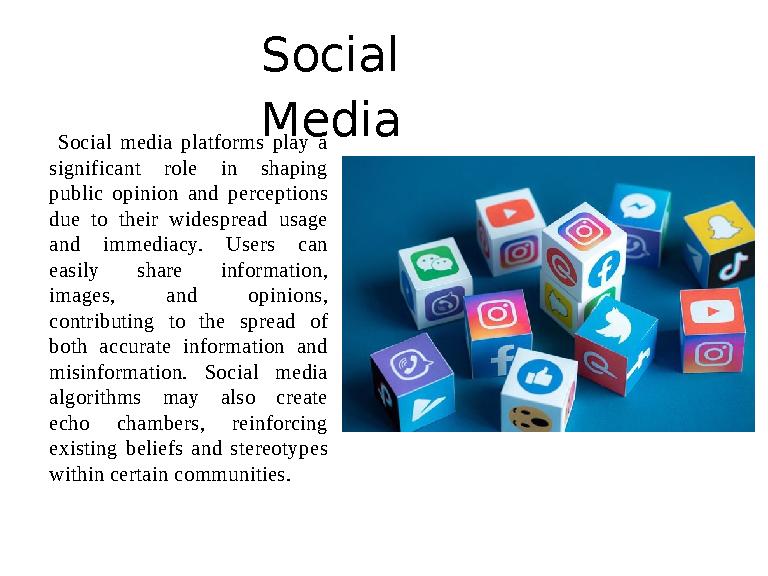
#7 слайд
Social
Media
Social media platforms play a
significant role in shaping
public opinion and perceptions
due to their widespread usage
and immediacy. Users can
easily share information,
images, and opinions,
contributing to the spread of
both accurate information and
misinformation. Social media
algorithms may also create
echo chambers, reinforcing
existing beliefs and stereotypes
within certain communities.
7 слайд
Social Media Social media platforms play a significant role in shaping public opinion and perceptions due to their widespread usage and immediacy. Users can easily share information, images, and opinions, contributing to the spread of both accurate information and misinformation. Social media algorithms may also create echo chambers, reinforcing existing beliefs and stereotypes within certain communities.

#8 слайд
Advertisi
ng
Advertising in various media
forms, such as print, digital,
and television, can reinforce or
challenge societal norms and
stereotypes. Advertisements
often portray idealized
versions of beauty, success,
and lifestyle, influencing
audience perceptions and
consumer behavior. For
example, ads featuring diverse
representation can promote
inclusivity and challenge
traditional beauty standards.
8 слайд
Advertisi ng Advertising in various media forms, such as print, digital, and television, can reinforce or challenge societal norms and stereotypes. Advertisements often portray idealized versions of beauty, success, and lifestyle, influencing audience perceptions and consumer behavior. For example, ads featuring diverse representation can promote inclusivity and challenge traditional beauty standards.
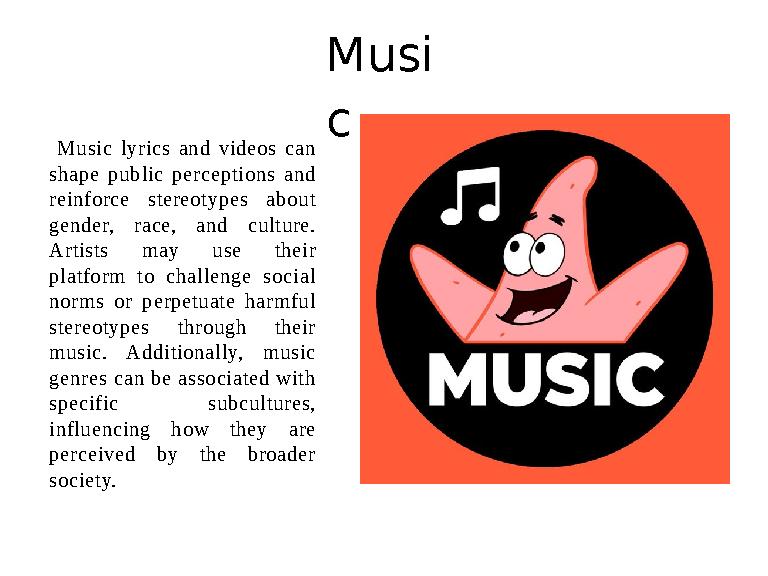
#9 слайд
Musi
c
Music lyrics and videos can
shape public perceptions and
reinforce stereotypes about
gender, race, and culture.
Artists may use their
platform to challenge social
norms or perpetuate harmful
stereotypes through their
music. Additionally, music
genres can be associated with
specific subcultures,
influencing how they are
perceived by the broader
society.
9 слайд
Musi c Music lyrics and videos can shape public perceptions and reinforce stereotypes about gender, race, and culture. Artists may use their platform to challenge social norms or perpetuate harmful stereotypes through their music. Additionally, music genres can be associated with specific subcultures, influencing how they are perceived by the broader society.
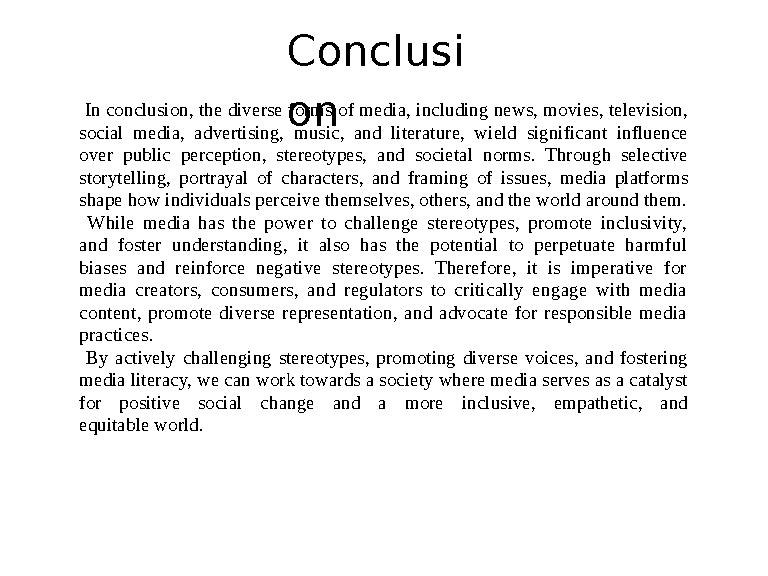
#10 слайд
Conclusi
on In conclusion, the diverse forms of media, including news, movies, television,
social media, advertising, music, and literature, wield significant influence
over public perception, stereotypes, and societal norms. Through selective
storytelling, portrayal of characters, and framing of issues, media platforms
shape how individuals perceive themselves, others, and the world around them.
While media has the power to challenge stereotypes, promote inclusivity,
and foster understanding, it also has the potential to perpetuate harmful
biases and reinforce negative stereotypes. Therefore, it is imperative for
media creators, consumers, and regulators to critically engage with media
content, promote diverse representation, and advocate for responsible media
practices.
By actively challenging stereotypes, promoting diverse voices, and fostering
media literacy, we can work towards a society where media serves as a catalyst
for positive social change and a more inclusive, empathetic, and
equitable world.
10 слайд
Conclusi on In conclusion, the diverse forms of media, including news, movies, television, social media, advertising, music, and literature, wield significant influence over public perception, stereotypes, and societal norms. Through selective storytelling, portrayal of characters, and framing of issues, media platforms shape how individuals perceive themselves, others, and the world around them. While media has the power to challenge stereotypes, promote inclusivity, and foster understanding, it also has the potential to perpetuate harmful biases and reinforce negative stereotypes. Therefore, it is imperative for media creators, consumers, and regulators to critically engage with media content, promote diverse representation, and advocate for responsible media practices. By actively challenging stereotypes, promoting diverse voices, and fostering media literacy, we can work towards a society where media serves as a catalyst for positive social change and a more inclusive, empathetic, and equitable world.

шағым қалдыра аласыз
















